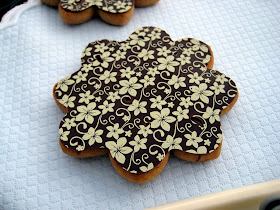
Another favorite combination of mine is chocolate, caramel and nuts, and I'm probably not alone here. I made this tart for a dinner party recently because it's a guaranteed crowd-pleaser. It's got a deep, buttery caramel almond filling, and is topped off with a ganache glaze that pairs perfectly with lightly sweetened whipped cream. The crust is ultra-simple, and comes together in the food processor in minutes. I like to use whole, blanched almonds for the filling. If you can only find whole unblanched almonds, just plunge them into boiling water for about 20 seconds. Drain, then cool them. The skins should slip off easily in your fingertips. Whole almonds yield the best crunch, but you can also use slivered blanched almonds, which are more readily available. The dough for the crust can be made up to three days ahead and stored, well-wrapped, in the refrigerator.
Chocolate Caramel Almond Tart
Serves 8
Crust:
1 cup all-purpose flour
3 tablespoons granulated sugar
Pinch of salt
6 tablespoons unsalted butter, cut into 1/2-inch dice and chilled well
2 tablespoons ice-cold water
Caramel Almond Layer:
3/4 cup blanched whole almonds
1 cup granulated sugar
1/4 teaspoon fresh lemon juice
1/2 cup heavy cream
2 tablespoons unsalted butter
1/4 teaspoon salt
1 teaspoon vanilla extract
Chocolate Truffle Layer:
2 ounces bittersweet chocolate, chopped
1/3 cup heavy cream
1 tablespoon unsalted butter, cut into 3 pieces
1/2 teaspoon vanilla extract
Make the crust:
1. Place the flour, sugar and salt in the bowl of a food processor and pulse a few times to combine. Add the butter pieces and toss lightly to coat with flour. Blend the butter and flour with about five 1-second pulses or until the mixture is the texture of coarse meal with some of the butter pieces the size of peas. Sprinkle the water over the flour mixture and process continuously until the dough begins to clump together. Do not over-process; the dough should not form a ball.
2. Turn the dough out onto a work surface and shape it into a thick 4-inch wide disk. Wrap the dough in plastic wrap and chill until firm enough to roll, about 30 minutes.
3. Place unwrapped dough on a work surface that has been lightly dusted with flour. Using a rolling pin, roll the dough out into an 11-inch circle, lifting and rotating the dough often, while dusting the work surface and dough lightly with flour as necessary. Roll the dough up on the rolling pin and unroll it ove a 9-inch fluted tart pan with a removable bottom. Gently press the dough onto the bottom and up the sides of the pan. Roll the pin over the top of the pan to trim off the excess dough. Lightly prick the bottom of the dough with a fork at 1/2-inch intervals. Refrigerate the dough in the pan for 20 minutes to firm up the dough.
Bake the crust:
4. Heat the oven to 350 degrees F. Right before baking, line the dough with foil and cover with pie weights or dried beans. Place the tart pan on a baking sheet and bake for 20 minutes. Carefully lift the foil (along with the weights) out of the tart pan and bake the crust for 10 to 15 minutes longer, or until golden brown. Leave the oven on. Transfer the tart pan to a wire rack and cool completely.
Make the caramel layer:
5. Toast the almonds on a baking sheet for 8 to 12 minutes, until golden. Let the nuts cool, then coarsely chop them and set aside. Fill a cup with water and place a pastry brush in it (this will be used for washing down the sides of the pan to prevent crystallization).
6. In a clean, heavy-bottomed 2-quart saucepan, stir together the sugar, 1/4 cup water and lemon juice. Place the saucepan over medium-high heat and cook, occasionally washing down the sides of the pan to wash away sugar crystals, until the mixture starts to color around the edges. Gently swirl the pan to ensure that the sugar caramelizes evenly and turns a medium-dark amber color.
7. Remove the pan from the heat and carefully add the heavy cream--the mixture will bubble up furiously, so be careful. Once the bubbling has subsided, add the butter and stir until completely melted. Whisk in the salt, vanilla and chopped almonds and stir until the nuts are completely coated. Pour the hot caramel mixture into the cooled tart shell, using a spoon to make sure that the nuts are evenly distributed. Let the caramel cool for 30 minutes, then refrigerate until the caramel is chilled, about 1 hour.
Make the truffle layer:
8. Place the chocolate and cream in a small saucepan over low heat and, stirring occasionally, cook until the chocolate is melted. While still on low heat, add the butter and stir until it is melted and the mixture is smooth. Stir in the vanilla. Pour the warm mixture over the caramel layer and smooth it into an even layer that covers all of the caramel. Refrigerate for at least 1 hour, until the chocolate is set. Serve the tart with sweetened whipped cream or vanilla ice cream, if you like.

